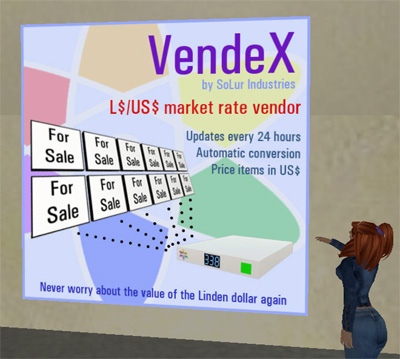The producer also benefits from the incessant growth of the economy. As more consumers enter SL, although their prices remain the same (or have to go down due to competition pressures), their sales rise, thus compensating to an extent the low pricing. A “much wanted” high-quality item can thus be sold as a lower cost, since many more people will be willing to buy it, and this offsets any possible “losses” due to price lowering.
We have to add a further aspect to the equation: the cost of setting prices. Most (but not all) creative artists in Second Life set their prices on textures for their vendors, something that really takes a lot of time to do. And this day, a major designer has thousands of articles for sale (just compare things at IMVU, which has an equivalent population to Second Life, but only around 100,000 items for sale, when you have over 20 million items being offered in Second Life!). Adjusting prices for thousands of items is far too costly ? in labour costs, it simply doesn’t “pay off” to change the price of a L$200 hair piece to L$250, and then to do the same the next week to L$300. Rather, the content designer has to evaluate the trade-off in losing a bit of money from a few sales and the tiring work to reset all prices on all vendors. It’s simply not worth the time! It’s far better to invest the time in developing new products instead, which will earn more sales ? and more income! ? than resetting prices. And this is what all major content designers do!
These days, you get more new users in just three days than the whole population of SL in mid-2004!
This reasoning makes our economy look very strange indeed ? comparing the L$/US$ ratio, what this means is that we have constant deflation (ie. things getting cheaper and cheaper all the time), although, technically, there are too many L$ in circulation (which is one of the criteria of inflation). While content designers can balance this equation by constantly adding new items, other professionals in SL cannot do the same. An example are the real estate agents. New land bought from a sim is constantly devaluated; fresh, new sims cost about L$ 6/m2, but in some cases people are not willing to pay that, and we’ve seen new land being offered for L$ 5/m2 or even less. Real estate agents are start to dump land just to avoid paying tier fees at the end of the month; and rentals have to raise prices all the time, since the L$ drops and drops. The consumer, however, is happy ? every day, he can get more L$ per US$, and while they might pay the same for rent, they’ll get cheaper items all the time.
The solution!
Well, at some point, there will be a rupture in the economy, and I think that the time has come (although, as said, these past few days have shown the L$ to be rather stable!).
Enter Sol Columbia’s solution: a vendor that allows price-marking in US$ (but payments are done in L$).

Her VendeX system is one of the first that I have seen. It works in a rather simple (and low-lag) way: it looks up the current exchange rate of the L$ vs. the US$, and updates prices accordingly. This means that the owner of the vendor ? that is, the creator selling content ? will set their prices in US$, but, when a customer comes in and wants to buy an item, the value in L$ on the “Fast Pay” button will automatically convert the US$ to L$, dynamically.
This means that the creator will now think about their content as costing “US dollars” ? say, a hair piece is set to cost half a dollar. They usually have a pretty good idea on how much their sales are on average, and now they can figure out how many dollars that is. This is naturally great for figuring out tier costs, or rental costs from landowners who use precisely the same system. In short, your hair might be for sale one day at L$140, the next at L$165, then for L$114, and the other day at L$137 ? but the content creator will always get the same: US$0.50.
For users this might be slightly confusing at first ? I can imagine them telling their friends that there was a bit of hair very cheap to be bought for L$112 on a certain shop (when the L$ was on the rise), but when the friends go there, the hair is priced at L$173 instead (when the L$ is falling). But it’s a question of time. They will very quickly say: “oh, the hair costs half a buck, I don’t know how much that is in L$ today”, since most people don’t bother to check the US$/L$ rate every day.
Starley Thereian, one of my long-time all-favourite clothes, hair, and shoe designers, has already started to test this model on a large scale.

Hard to find something I like… so many choices!
The choices are already quite impressive, and she promises her faithful buyers that she’ll expand them to cover all areas. From what I’ve gathered, she’s not the only one ? only one of many who has already a lot to offer using this new business model. Since her shop Celestial Studios is set in the Celestial City sim, where other great designers already have their shops as well, it’s not hard to imagine that the other content designers there will quickly follow her steps. And this will very likely become the de facto standard for the major content designers ? the ones that truly live from their income as creative designers, and the ones that are more affected by the constant L$ devaluation.
One might not forget that some very talented designers have been frustrated and already abandoned their creative impulses just because it was impossible to establish a fixed income from their sales. Consumers apparently dislike the idea that producers fix new prices to reflect the devaluation of the L$; on the other hand, Sol’s new model does that automatically, by fixing prices in US$ instead. The consumer will not feel cheated; they’re just using a strong currency that does not fluctuate (much) instead of a weak one that is constantly devaluating. You can go even further. A new user, these days, does not have any idea on how much they’ll need to spend to get a “nice” avatar ? with a skin, a good outfit, primmed clothes and hair, and the usual assortment of attachments. But using Sol’s device and shopping at Starley’s, well, they can know exactly how much they’ll spend ? say, US$10 for everything. This is something that can be advertised: “Your fabulous avatar for just US$10 ? a bargain!” And this advertisement will be true even in 2050, when you can buy L$ 10,000 (or ten million!) for one dollar.
People will start (again) to think in content being worth real money, since prices will be shown in a real, stable, strong currency.




